Exploring the Vibrant Cultural Heartbeat of Sofia, Bulgaria
Sofia, the capital city of Bulgaria, offers a unique blend of history, art, and culture that appeals to visitors from around the world.
Nestled in the heart of the city is the KvARTal district, known for its vibrant art scene. The most significant street art mural in this district was created by artists Nasimo and Sani Gh. The Hug and Tulip Girl (Serdika Tulip) by Arsek & Erase are just a few examples of the accomplished street art murals that adorn the district's walls.
For those with an interest in history, the National History Museum in Sofia is a must-visit. As the largest museum in Bulgaria, it houses a vast collection spanning millennia, providing a comprehensive overview of the country's past.
Art enthusiasts will find solace in the National Gallery, home to over 40,000 paintings, sculptures, and graphic works across several branches. The newest and largest building, Kvadrat 500, is a testament to the gallery's commitment to showcasing and preserving Bulgarian art.
The Regional History Museum in Sofia offers exhibits from the Neolithic era up to the 1940s, providing a deep dive into the city's historical evolution.
Sofia's food scene is diverse and vibrant, with Vitosha Boulevard, KvARTal district, Tsar Shishman Street, and the Women's Market being popular destinations for food lovers. Whether you're craving Bulgarian cuisine or international flavours, Sofia has something to satisfy every palate.
Music lovers will find plenty to enjoy in Sofia as well. The city hosts several music festivals throughout the year, including A to JazZ, Sofia Live, and the International Film Festival. A to JazZ, held in July, has featured legends such as Branford Marsalis, John McLaughlin, and Kenny Garrett. Sofia Live, a three-day multi-genre festival in June, showcases both big-name artists and local emerging talent.
For those who prefer outdoor activities, the Vitosha massif, located six miles south of the city, offers hiking, mountain biking, skiing, and sledging opportunities. Its highest peak, Cherni Vrah, stands at 7,513ft.
In December, visitors can find several festive markets located around Sofia, adding a touch of holiday cheer to the city.
The Rotunda Church of St George, a red brick building dating back to the 4th century CE, is one of the oldest surviving buildings in Sofia. The Boyana Church, located in the southwest of Sofia, is a UNESCO-listed church known for its impressive medieval frescoes. The St Alexander Nevsky Cathedral, a Neo-Byzantine construction most of which dates to the early 20th century, is another architectural marvel that can hold a congregation of several thousand people.
Lastly, the Red Flat in Sofia invites visitors to step back into 1980s Communist Bulgaria, offering a unique insight into the city's recent history. The Basilica of St Sofia, located in Sofia, houses an underground museum showcasing the remains of several earlier churches and a Roman-era necropolis.
The Lunar Festival of Lights in May and the Aniventure Comic Con in July are other highlights that transform Sofia into a vibrant hub of culture and entertainment. The Wizz Air Sofia Marathon in October attracts thousands of runners each year, making it a significant event on the city's calendar.
Sofia, with its rich history, vibrant art scene, and diverse food and music offerings, is a city that truly has something for everyone. Whether you're a history buff, an art lover, a foodie, or a music enthusiast, Sofia is a destination worth exploring.
Read also:
- Impact of Alcohol on the Human Body: Nine Aspects of Health Alteration Due to Alcohol Consumption
- Understanding the Concept of Obesity
- Tough choices on August 13, 2025 for those born under Aquarius? Consider the advantages and disadvantages to gain guidance
- Microbiome's Impact on Emotional States, Judgement, and Mental Health Conditions







